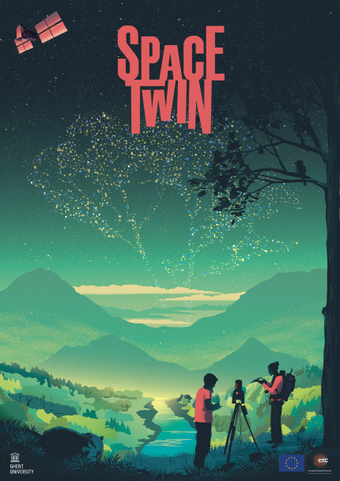Kim Calders - SPACETWIN
Introduction
The ERC Starting Grant SPACETWIN, "Digital twins for understanding forest disturbances and recovery from space", is led by prof. Kim Calders (Ghent University, Belgium). The project will run from November 2022 until September 2027 and will use digital forest models to boost our understanding of forest dynamics.
Project description
Forests worldwide are undergoing large-scale and unprecedented changes in terms of structure and species composition due to anthropogenic disturbances, climate change and other global change drivers. Climate, disturbances and forest structure are all closely linked: changes in climate can lead directly to physical changes in forest structure and vice versa or to an anticipated increase in forest disturbances. However, it is still uncertain how forest structure is impacted by disturbances (locally) and how we can detect and monitor various levels of disturbance regimes using spaceborne satellite data (globally). The EU-funded SPACETWIN project will investigate how drought, fire and logging disturbances affect a range of tropical and temperate forest ecosystems. Using the most detailed structural and radiometric 3D forest models ever built, SPACETWIN will digitally reproduce real-world forest areas. These so-called ‘digital twins’ will enhance our ability to observe, quantify and understand forest disturbances.
Innovations
The key innovations will be: (1) the establishment of an unprecedented 4D dataset across 57 disturbed sites using terrestrial laser scanning (~11,500 individual trees); (2) the development of next generation methods to enable big data science of forest point clouds; (3) the identification of key axes of variation of disturbed tree and forest structure; (4) the first ever implementation of digital twins for optical and microwave radiative transfer modelling; (5) the near-real time inversion of remote sensing of forest disturbances using emulation; and (6) the embedding of forest structure in the global observation process to understand the uncertainties in monitoring disturbances.
These innovations will open a realm of untapped research questions and applications that call for the most detailed 3D information on canopy structure possible. These insights are also urgently needed to reduce uncertainties and advance the forecasting of carbon stocks and dynamics within the context of the IPCC.
Website
Contact
Prof. Kim Calders
Department of Environment
E-mail
Funding info
Disclaimer
Funded by the European Union. Views and opinions expressed are however those of the author(s) only and do not necessarily reflect those of the European Union of the European Research Council Executive Agency (ERCEA). Neither the European Union nor the authority can be held responsible for them.

